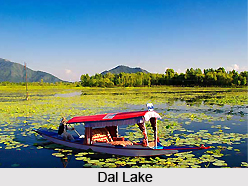 The Dal Lake is a popular lake situated in Srinagar district of Jammu and Kashmir. The lake is linked to a number of other lakes of the Kashmir Valley. The river is famous for the Shikaras and wooden Houseboats. All these factors have attracted tourists from far and wide and therefore it is a popular tourist destination.
The Dal Lake is a popular lake situated in Srinagar district of Jammu and Kashmir. The lake is linked to a number of other lakes of the Kashmir Valley. The river is famous for the Shikaras and wooden Houseboats. All these factors have attracted tourists from far and wide and therefore it is a popular tourist destination.
History of Dal Lake
Dal Lake finds mention in ancient Sanskrit texts as Mahasarit. History states that a village named Isabar to the east of Dal Lake was the residence of goddess Durga. This place was called Sureshwari on the bank of the lake.
At the time of Mughal period, the Mughal rulers of India selected Srinagar as their summer resort. They adorned the precincts of Dal Lake in Srinagar with expansive Mughal-type gardens. During the British Raj, the British were also wooed by the beauty of Dal Lake and they made Srinagar their capital during the summer months.
Geography of Dal Lake
The lake is spread over an area of eighteen square kilometres. It is eight metres in length and four kilometres in width. The average elevation of the lake is 1,583 metres. The depth of water varies from 6 metres at its deepest to 2.5 metres at its shallowest. It is divided into four parts by four causeways and they are called Ggribal, Lokut Dal, Bod Dal and Nagin. The Lokut-dal and Bod-dal both have an island in the centre, which are called Rup Lank and Sona Lank respectively. The shore of the Lake is embellished with gardens, parks and hotels.
Economical Significance of Dal Lake
 The fishing industry on Dal Lake is the second largest industry in the region. The lake water is used for irrigation of fields and the aquatic plants growing in the lake are used as food, fodder and compost. Many people who reside on its periphery are dependent on its water.
The fishing industry on Dal Lake is the second largest industry in the region. The lake water is used for irrigation of fields and the aquatic plants growing in the lake are used as food, fodder and compost. Many people who reside on its periphery are dependent on its water.
Attractions of Dal Lake
The lake is surrounded by mountains on three sides. It is rich in flora and fauna. The flora includes water lilies and water chestnuts. The lake is renowned in particular for its Nelumbo nucifera which is a lotus flower which blooms in the months of July and August. Floating gardens are another attraction of this lake.
The valley also houses a rich cultivation of crops such as paddy, wheat and fodder. The Woody vegetation is also impressive which comprises of Melia, Ailanthus, Robinia, Daphne, Celtis, Rose, Ephedra, Pinus roxburghii, Pinus halepensis, Pinus gerardiana, Cupressus torulosa and Cupressus arizonica.
The other attractions of this lake are water sports which includes swimming, boating, snow skiing and canoeing. The lake also has numerous sites and places of interest under which come Shalimar Bagh, Nishat Bagh, Shankaracharya temple, the Hari Parbat, the Nagin Lake, the Chashme Shahi, the Hazratbal Shrine, the famous Kashmir houseboat and the shikara called the Gandola of Kashmir.
Connectivity of Dal Lake
Dal Lake can be well accessed by rail and air links. The closest railway station is 300 kilometres (190 mi) away at Jammu. The nearest airport is about 7 kilometres away at Badgam.















